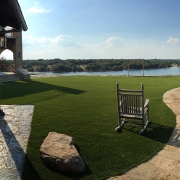History of Synthetic Grass
[vc_row][vc_column width=”1/1″][vc_single_image image=”255″ border_color=”grey” img_link_target=”_self” img_size=”full”][dt_gap height=”15″][dt_fancy_separator separator_style=”dotted” separator_color=”accent” el_width=”100″][dt_gap height=”5″][vc_column_text]
Synthetic grass lawns are made from something known as artificial turf. The idea behind this is simply to mimic the look and feel of natural grass using synthetic materials. This has many benefits allowing you to create a ‘luscious’ and green environment where you might be unable to maintain healthy grass otherwise. For example if you have a lawn that is constantly walked on, perhaps in a commercial area for example, then replacing these with synthetic grass lawns will mean that others can walk on it without it dying. Another popular use for them is in sports where the grass creates the image associated with the sport while providing a soft ground to play on that won’t become muddy or dry.
Similarly these are very useful in extremely hot areas where grass either can’t grow at all or looks very dry, or in very wet places where the grass would otherwise appear muddy or dirty. They can also be used by those who simply don’t want, or don’t have the time and resources, to maintain the grass themselves. This way synthetic grass lawns always end up looking well kept and that reflects well on the grounds and the business or individual that reside there.
Generally though synthetic grass lawns look very realistic (particularly on television), it’s usually possible to tell them by the feel of the grass. There are multiple types of synthetic grass lawns and they have developed considerably over the years. The first notable example of artificial turf was created by a team lead by David Chaney who was at the time dean of the North Carolina State University. The first applications of this was generally in sports and Sports Illustrated would declare Chaney as responsible for making indoor baseball possible. In 1965 artificial turf became more popular and more widely used with the introduction of AstroTurf installed in the then-new Astrodome, Texas. This use spread to other sports and countries and was soon seen in European football in certain teams that sported ‘plastic pitches’ (as they were often known). In 1988 however they were banned by the English Football Association. This was partly due to the turf being too hard to be used for sports and creating injuries. This lead to the development of softer and more forgiving turf which used rubber infill and tiny spring-like devices – touted as being as safe as playing on normal grass and in some ways safer due to them not being affected by weather. This has seen AstroTurf and other such artificial grass gain more widespread acceptance in sport once again.
This was not an issue for the commercial uses of turf however which in the 1990s began to be seen more and more in landscaping. It is now seen in not only commercial landscaping but also in residential areas – particularly ‘community’ areas such as retirement villages and psychiatric homes. As the variety of synthetic grass lawns has greatly increased and as water conservation groups see the value of these measures, the use of synthetic grass only looks set to continue.
Article Source: http://EzineArticles.com/?expert=Carol_Conway[/vc_column_text][/vc_column][/vc_row]

